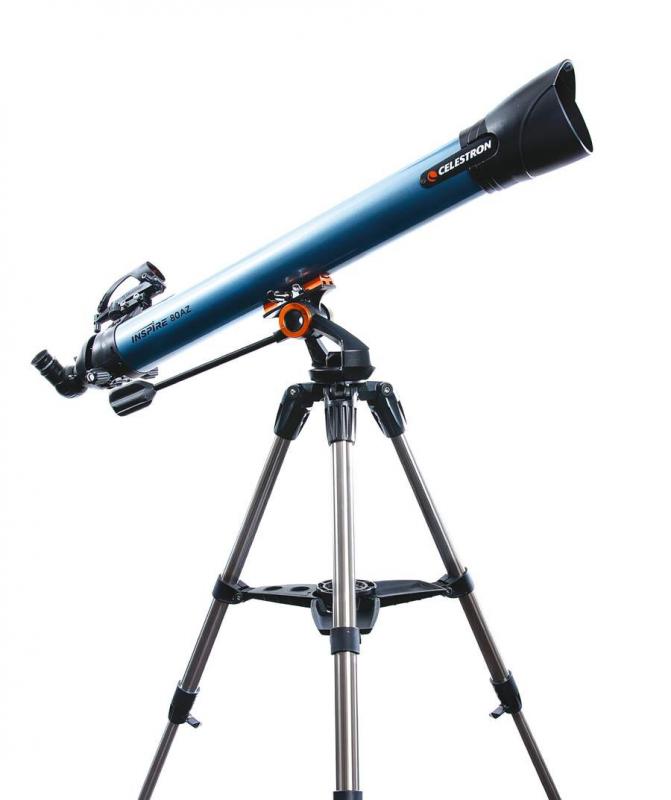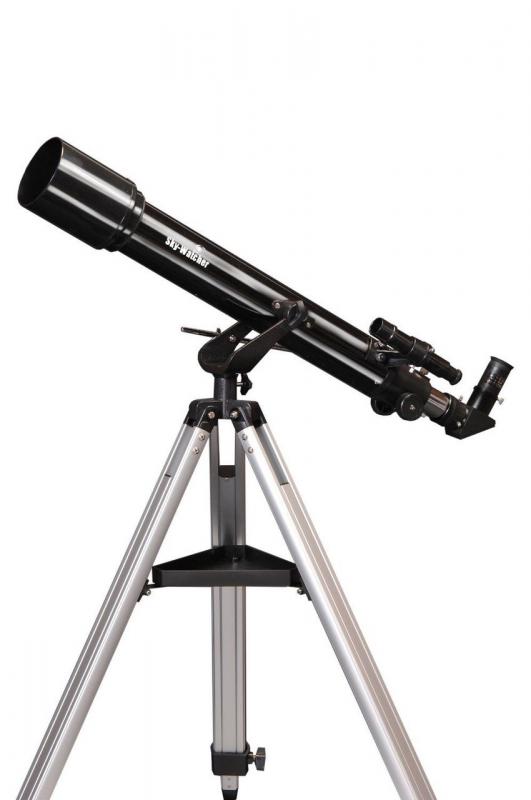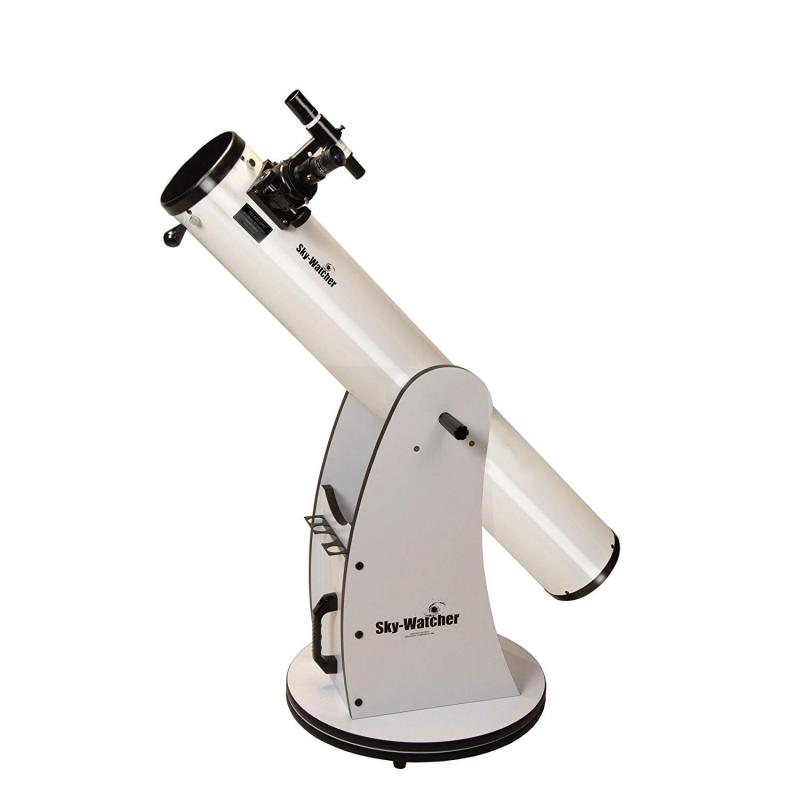2018 October 13
What telescope should I give a child?
I have had quite a bit of correspondence since the announcement of the existence of the new Equipment & Techniques Section. One question of particular importance that came my way was ‘What is the best telescope to get for a child interested in space?’
This is a question that is also commonly asked by members of the public at stargazing events. My answer of course will have a strong dose of personal opinions in it, and I welcome discussion on the subject. Patrick Moore always used to encourage children and other beginners to gain experience using binoculars first rather than hanker after a telescope. The counter-argument to this is that it does not usually stop them wanting telescopes. They can see a telescope is the ‘thing to have’ if you are an astronomer, and binoculars will not show you details on the planets, nor much on the Moon, without mounting them, which is quite a difficult issue to overcome in itself. Astronomical telescopes start with the big advantage of being mounted in some fashion.
So I will consider the most basic astronomical telescopes: those under the £150 mark. My tack with the potential purchaser, usually the parent, is first to explain the main practical issue with all telescopes: stability, and flowing from that, usability. It’s not obvious to someone with no knowledge that, the purpose of telescopes being that they magnify objects greatly, they will also magnify the slightest vibration and puff of wind, so that a telescope with an inadequate mount will have the image flying all over the place and it will never be possible to focus it on an object. Virtually all telescopes sold today are optically acceptable: they do work, but at the bottom end of the market, in my experience, the usual problem is just pointing them at an object and getting them to stay there, without jumping or swinging back, due to stiffness, lack of balance, or backlash in a poorly-engineered mount.
I do not recommend equatorial mounts for beginners. There are indeed some scopes on German Equatorial mounts (GEMs) within our stated price-bracket. But consider that a GEM is a complex, cantilevered piece of engineering, the telescope overhung on the tripod in two directions. To be stable, this requires a weight and quality of construction not possible in a beginners’ telescope. Moreover, most people are totally confused by GEMs, not knowing how to set up the alignment, balance them, or use the axes, clutches and slow motions. Most often you see beginners trying to point them by swivelling the whole GEM around the tripod-centre azimuth adjustment bolt, with the polar axis set at a crazy angle, and using the highest-power eyepiece they have, often with a Barlow lens as well, predictably failing to achieve anything.

So we are looking at those with tripods. Unfortunately, most of those currently in this price bracket seem to be designed more with wildlife observation in mind than pointing at the sky, with altazimuth heads that resemble those of camera tripods. These simply do not work when pointing a telescope at a high altitude, because the azimuth bearing is outside the tube, and the tube will fall back therefore under its own weight, unless the bearing is clamped tight, in which case there will be too much backlash from the legs and whole structure to allow even initial pointing of the scope, let alone manual siderial tracking to keep the object centred. Another aspect of the terrestrial bias of design is the provision of erecting diagonals on these telescopes, unlikely to yield first-class images.

If the budget will stretch to a little over £200, 150mm Dobsonian telescopes represent superb value and usability for the beginner. Once again, 
David Arditti Director, Equipment & Techniques Section
https://britastro.org/wp-content/uploads/2022/02/A759AC6C-4E3C-48FC-85BA-33F7F4515812.jpeg
https://britastro.org/wp-content/uploads/2022/02/A759AC6C-4E3C-48FC-85BA-33F7F4515812.jpeg
https://britastro.org/wp-content/uploads/2022/02/A759AC6C-4E3C-48FC-85BA-33F7F4515812.jpeg
https://britastro.org/wp-content/uploads/2022/02/A759AC6C-4E3C-48FC-85BA-33F7F4515812.jpeg
https://britastro.org/wp-content/uploads/2022/02/A759AC6C-4E3C-48FC-85BA-33F7F4515812.jpeg
https://britastro.org/wp-content/uploads/2022/02/A759AC6C-4E3C-48FC-85BA-33F7F4515812.jpeg
https://britastro.org/wp-content/uploads/2022/02/A759AC6C-4E3C-48FC-85BA-33F7F4515812.jpeg
https://britastro.org/wp-content/uploads/2022/02/A759AC6C-4E3C-48FC-85BA-33F7F4515812.jpeg
https://britastro.org/wp-content/uploads/2022/02/A759AC6C-4E3C-48FC-85BA-33F7F4515812.jpeg
https://britastro.org/wp-content/uploads/2022/02/A759AC6C-4E3C-48FC-85BA-33F7F4515812.jpeg
https://britastro.org/wp-content/uploads/2022/02/A759AC6C-4E3C-48FC-85BA-33F7F4515812.jpeg
https://britastro.org/wp-content/uploads/2022/02/A759AC6C-4E3C-48FC-85BA-33F7F4515812.jpeg
https://britastro.org/wp-content/uploads/2022/02/A759AC6C-4E3C-48FC-85BA-33F7F4515812.jpeg
https://britastro.org/wp-content/uploads/2022/02/A759AC6C-4E3C-48FC-85BA-33F7F4515812.jpeg
https://britastro.org/wp-content/uploads/2022/02/A759AC6C-4E3C-48FC-85BA-33F7F4515812.jpeg
https://britastro.org/wp-content/uploads/2022/02/A759AC6C-4E3C-48FC-85BA-33F7F4515812.jpeg
https://britastro.org/wp-content/uploads/2022/02/A759AC6C-4E3C-48FC-85BA-33F7F4515812.jpeg
https://britastro.org/wp-content/uploads/2022/02/A759AC6C-4E3C-48FC-85BA-33F7F4515812.jpeg
https://britastro.org/wp-content/uploads/2022/02/A759AC6C-4E3C-48FC-85BA-33F7F4515812.jpeg
https://britastro.org/wp-content/uploads/2022/02/A759AC6C-4E3C-48FC-85BA-33F7F4515812.jpeg
https://britastro.org/wp-content/uploads/2022/02/A759AC6C-4E3C-48FC-85BA-33F7F4515812.jpeg
https://britastro.org/wp-content/uploads/2022/02/A759AC6C-4E3C-48FC-85BA-33F7F4515812.jpeg
https://britastro.org/wp-content/uploads/2022/02/A759AC6C-4E3C-48FC-85BA-33F7F4515812.jpeg
https://britastro.org/wp-content/uploads/2022/03/A759AC6C-4E3C-48FC-85BA-33F7F4515812.jpeg
https://britastro.org/wp-content/uploads/2022/03/A759AC6C-4E3C-48FC-85BA-33F7F4515812.jpeg
https://britastro.org/wp-content/uploads/2022/03/A759AC6C-4E3C-48FC-85BA-33F7F4515812.jpeg
https://britastro.org/wp-content/uploads/2022/03/A759AC6C-4E3C-48FC-85BA-33F7F4515812.jpeg
https://britastro.org/wp-content/uploads/2022/02/A759AC6C-4E3C-48FC-85BA-33F7F4515812.jpeg
https://britastro.org/wp-content/uploads/2022/02/A759AC6C-4E3C-48FC-85BA-33F7F4515812.jpeg
https://britastro.org/wp-content/uploads/2022/02/A759AC6C-4E3C-48FC-85BA-33F7F4515812.jpeg
https://britastro.org/wp-content/uploads/2022/02/A759AC6C-4E3C-48FC-85BA-33F7F4515812.jpeg
https://britastro.org/wp-content/uploads/2022/02/A759AC6C-4E3C-48FC-85BA-33F7F4515812.jpeg
https://britastro.org/wp-content/uploads/2022/02/A759AC6C-4E3C-48FC-85BA-33F7F4515812.jpeg
https://britastro.org/wp-content/uploads/2022/02/A759AC6C-4E3C-48FC-85BA-33F7F4515812.jpeg
https://britastro.org/wp-content/uploads/2022/02/A759AC6C-4E3C-48FC-85BA-33F7F4515812.jpeg
https://britastro.org/wp-content/uploads/2022/02/A759AC6C-4E3C-48FC-85BA-33F7F4515812.jpeg
https://britastro.org/wp-content/uploads/2022/02/A759AC6C-4E3C-48FC-85BA-33F7F4515812.jpeg
https://britastro.org/wp-content/uploads/2022/02/A759AC6C-4E3C-48FC-85BA-33F7F4515812.jpeg
https://britastro.org/wp-content/uploads/2022/02/A759AC6C-4E3C-48FC-85BA-33F7F4515812.jpeg
https://britastro.org/wp-content/uploads/2022/02/A759AC6C-4E3C-48FC-85BA-33F7F4515812.jpeg
https://britastro.org/wp-content/uploads/2022/02/A759AC6C-4E3C-48FC-85BA-33F7F4515812.jpeg
https://britastro.org/wp-content/uploads/2022/02/A759AC6C-4E3C-48FC-85BA-33F7F4515812.jpeg
https://britastro.org/wp-content/uploads/2022/02/A759AC6C-4E3C-48FC-85BA-33F7F4515812.jpeg
https://britastro.org/wp-content/uploads/2022/01/A759AC6C-4E3C-48FC-85BA-33F7F4515812.jpeg
https://britastro.org/wp-content/uploads/2022/02/A759AC6C-4E3C-48FC-85BA-33F7F4515812.jpeg
https://britastro.org/wp-content/uploads/2022/02/A759AC6C-4E3C-48FC-85BA-33F7F4515812.jpeg
https://britastro.org/wp-content/uploads/2022/01/A759AC6C-4E3C-48FC-85BA-33F7F4515812.jpeg
https://britastro.org/wp-content/uploads/2022/01/A759AC6C-4E3C-48FC-85BA-33F7F4515812.jpeg
https://britastro.org/wp-content/uploads/2022/01/A759AC6C-4E3C-48FC-85BA-33F7F4515812.jpeg
https://britastro.org/wp-content/uploads/2022/01/A759AC6C-4E3C-48FC-85BA-33F7F4515812.jpeg
https://britastro.org/wp-content/uploads/2022/01/A759AC6C-4E3C-48FC-85BA-33F7F4515812.jpeg
https://britastro.org/wp-content/uploads/2022/01/A759AC6C-4E3C-48FC-85BA-33F7F4515812.jpeg
https://britastro.org/wp-content/uploads/2022/01/A759AC6C-4E3C-48FC-85BA-33F7F4515812.jpeg
https://britastro.org/wp-content/uploads/2022/01/A759AC6C-4E3C-48FC-85BA-33F7F4515812.jpeg
https://britastro.org/wp-content/uploads/2022/02/A759AC6C-4E3C-48FC-85BA-33F7F4515812.jpeg
https://britastro.org/wp-content/uploads/2021/11/A759AC6C-4E3C-48FC-85BA-33F7F4515812.jpeg
https://britastro.org/wp-content/uploads/2021/11/A759AC6C-4E3C-48FC-85BA-33F7F4515812.jpeg
https://britastro.org/wp-content/uploads/2021/11/A759AC6C-4E3C-48FC-85BA-33F7F4515812.jpeg
https://britastro.org/wp-content/uploads/2021/11/A759AC6C-4E3C-48FC-85BA-33F7F4515812.jpeg
https://britastro.org/wp-content/uploads/2021/07/A759AC6C-4E3C-48FC-85BA-33F7F4515812.jpeg
https://britastro.org/wp-content/uploads/2021/07/A759AC6C-4E3C-48FC-85BA-33F7F4515812.jpeg
https://britastro.org/wp-content/uploads/2018/10/A759AC6C-4E3C-48FC-85BA-33F7F4515812.jpeg
https://britastro.org/wp-content/uploads/2018/10/D298C315-00D4-458C-AE07-6A820819C702.jpeg
https://britastro.org/wp-content/uploads/2018/10/CA4A3AC3-0C06-4ACC-AFCF-58936BA92E76.jpeg
https://britastro.org/wp-content/uploads/2018/10/FEC79BBC-9597-49AD-8F37-57560A7D77F4.jpeg
https://britastro.org/wp-content/uploads/2022/02/A759AC6C-4E3C-48FC-85BA-33F7F4515812.jpeg
https://britastro.org/wp-content/uploads/2022/02/A759AC6C-4E3C-48FC-85BA-33F7F4515812.jpeg
https://britastro.org/wp-content/uploads/2022/02/A759AC6C-4E3C-48FC-85BA-33F7F4515812.jpeg
https://britastro.org/wp-content/uploads/2022/02/A759AC6C-4E3C-48FC-85BA-33F7F4515812.jpeg
https://britastro.org/wp-content/uploads/2022/02/A759AC6C-4E3C-48FC-85BA-33F7F4515812.jpeg
https://britastro.org/wp-content/uploads/2022/02/A759AC6C-4E3C-48FC-85BA-33F7F4515812.jpeg
https://britastro.org/wp-content/uploads/2022/02/A759AC6C-4E3C-48FC-85BA-33F7F4515812.jpeg
https://britastro.org/wp-content/uploads/2022/02/A759AC6C-4E3C-48FC-85BA-33F7F4515812.jpeg
https://britastro.org/wp-content/uploads/2022/02/A759AC6C-4E3C-48FC-85BA-33F7F4515812.jpeg
https://britastro.org/wp-content/uploads/2022/02/A759AC6C-4E3C-48FC-85BA-33F7F4515812.jpeg
https://britastro.org/wp-content/uploads/2022/02/A759AC6C-4E3C-48FC-85BA-33F7F4515812.jpeg
https://britastro.org/wp-content/uploads/2018/10/CA4A3AC3-0C06-4ACC-AFCF-58936BA92E76.jpeg
https://britastro.org/wp-content/uploads/2022/02/A759AC6C-4E3C-48FC-85BA-33F7F4515812.jpeg
https://britastro.org/wp-content/uploads/2022/02/A759AC6C-4E3C-48FC-85BA-33F7F4515812.jpeg
https://britastro.org/wp-content/uploads/2022/02/A759AC6C-4E3C-48FC-85BA-33F7F4515812.jpeg
https://britastro.org/wp-content/uploads/2022/02/A759AC6C-4E3C-48FC-85BA-33F7F4515812.jpeg
https://britastro.org/wp-content/uploads/2022/02/A759AC6C-4E3C-48FC-85BA-33F7F4515812.jpeg
https://britastro.org/wp-content/uploads/2022/02/A759AC6C-4E3C-48FC-85BA-33F7F4515812.jpeg
https://britastro.org/wp-content/uploads/2022/02/A759AC6C-4E3C-48FC-85BA-33F7F4515812.jpeg
https://britastro.org/wp-content/uploads/2022/02/A759AC6C-4E3C-48FC-85BA-33F7F4515812.jpeg
https://britastro.org/wp-content/uploads/2022/02/A759AC6C-4E3C-48FC-85BA-33F7F4515812.jpeg
| The British Astronomical Association supports amateur astronomers around the UK and the rest of the world. Find out more about the BAA or join us. |
